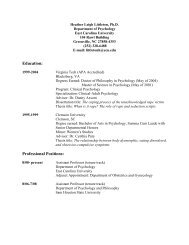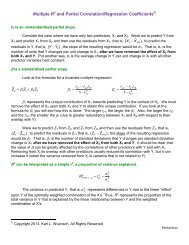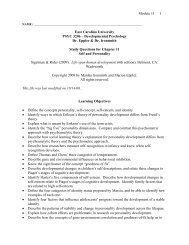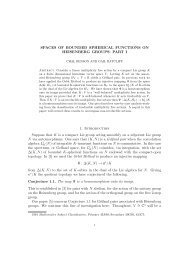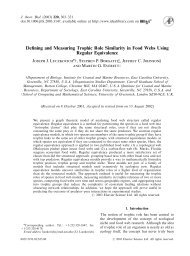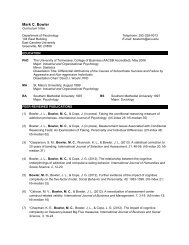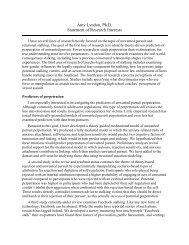Modeling Information for Three-Dimensional Space - Ecu
Modeling Information for Three-Dimensional Space - Ecu
Modeling Information for Three-Dimensional Space - Ecu
Create successful ePaper yourself
Turn your PDF publications into a flip-book with our unique Google optimized e-Paper software.
Carliner<br />
APPLIED RESEARCH<br />
Lessons Learned from Museum Exhibit Design<br />
to place it on display as a touch object.<br />
The public programs and education staffs can enhance<br />
the sense of “wow” in an exhibit. Public programs are those<br />
aimed at the general public. Sometimes the programs involve<br />
craftspeople demonstrating a type of craft on display.<br />
For example, the Fruitlands Museum in Harvard, MA,<br />
scheduled demonstrations by carpenters and blacksmiths<br />
to complement its exhibit of tools. Science museums often<br />
schedule demonstrations. For example, SciTrek, the Science<br />
and Technology Museum of Atlanta, schedules several<br />
demonstrations each day.<br />
The education staff focuses almost exclusively on<br />
school groups visiting the museum. According to the museum<br />
educator at the urban history museum I studied, her<br />
colleagues at other museums typically develop scavenger<br />
hunts and activity baskets as tools to help young visitors<br />
notice all parts of an exhibit or focus on parts of special<br />
interests to their teachers (if the students attend with a<br />
school group). The idea implementer at the industrial history<br />
museum in my study added that she also develops<br />
materials that classroom teachers can use to prepare students<br />
<strong>for</strong> an upcoming visit and debrief the visit afterwards.<br />
Lessons <strong>for</strong> Web design<br />
As exhibit designers try to “wow” visitors with provocative<br />
subjects, interactivity, and similar techniques, so must Web<br />
site designers. One particular area of interest to Web site<br />
designers is the design of the interaction between users and<br />
the computer. Web site designers try to “wow” users in a<br />
number of ways.<br />
“Splash” screens, which display a brief animated sequence,<br />
are intended to capture and hold user interest.<br />
Web sites <strong>for</strong> commercial films, <strong>for</strong> example,<br />
usually start with an elaborate splash screen intended<br />
to generate excitement about the film. But<br />
the scene must splash quickly, or visitors will surf<br />
elsewhere.<br />
Profiling—the act of capturing in<strong>for</strong>mation about a<br />
given user and using that in<strong>for</strong>mation to tailor the<br />
Web site to that user’s interests—attempts to “wow”<br />
visitors through personalization.<br />
Online communities and scheduled chats can foster<br />
a sense of loyalty among users and increase the<br />
number of visits to the site, just as public programs<br />
and education are also intended to help visitors discover<br />
parts of museum exhibits.<br />
Two challenges face designers in bringing “wow” to<br />
their Web sites. The first pertains to technology. With each<br />
technical development often comes a new means of “wowing”<br />
users. But the challenge to Web site designers is<br />
finding techniques that engage users within the context of<br />
the Web site content, rather than as merely demonstrating<br />
the technology.<br />
Furthermore, the same technologies that let Web sites<br />
develop and enhance profiles of users also involve an<br />
invasion of user privacy. Web site designers must determine<br />
at what point the value of better knowing users<br />
exceeds the risk of offending users by collecting and using<br />
in<strong>for</strong>mation that users might not want anyone to be collecting.<br />
European law severely limits such practices. In<br />
contrast, American Internet users have shown a surprisingly<br />
high tolerance to tracking.<br />
The second challenge facing designers in bringing<br />
“wow” to their Web sites comes from the almost religious<br />
battle between usability experts and graphic designers on<br />
ideal approaches to Web design. Usability experts, led by<br />
the likes of Jakob Nielsen, tend to focus on observable,<br />
measurable patterns of effectiveness that can be independently<br />
verified through usability research. But measuring<br />
affective responses like “wow” will tax even the bestrefined<br />
research methodologies, and graphic designers and<br />
others with backgrounds in the arts and humanities are<br />
often hard pressed to produce data from universal research<br />
that would support the use of nonstandard approaches,<br />
like those of storytelling (Cloninger 2000).<br />
7. AVOID “SOUND BLEED” AND OTHER MEDIA NIGHTMARES.<br />
What I observed in museums<br />
Two thirds of the way up the back wall of the entrance<br />
lobby to the Walker Art Center in Minneapolis is a horizontal<br />
line of lights that lead around a curve and beckon<br />
visitors through a hidden doorway. Beyond the doorway is<br />
a long, low, dark theater with built-in benches. On the<br />
three oversized screens at the front of this theater, a slide<br />
and sound show continuously plays. It introduces visitors<br />
to the primary temporary exhibit. When visitors leave the<br />
theater, they walk up a half a flight of stairs and enter that<br />
exhibit.<br />
Visitors need no beckoning lights to see the “[city] in<br />
your face” video in the city history exhibit at the urban<br />
history museum I studied. It simultaneously plays on 12<br />
monitors of various sizes hanging from the ceiling at the<br />
entrance to the exhibit. A glass wall behind the monitors<br />
gives visitors a glimpse into each of the four galleries;<br />
visitors can enter any gallery they choose.<br />
At the end of a visit to the exhibit on the canning<br />
factory in my study, visitors participate in a computer-<br />
One particular area of interest to<br />
Web site designers is the design of<br />
the interaction between users and<br />
the computer.<br />
Volume 48, Number 1, February 2001 • TechnicalCOMMUNICATION 77



